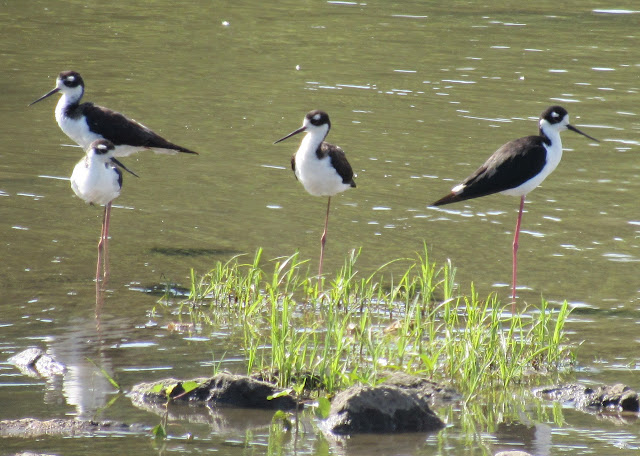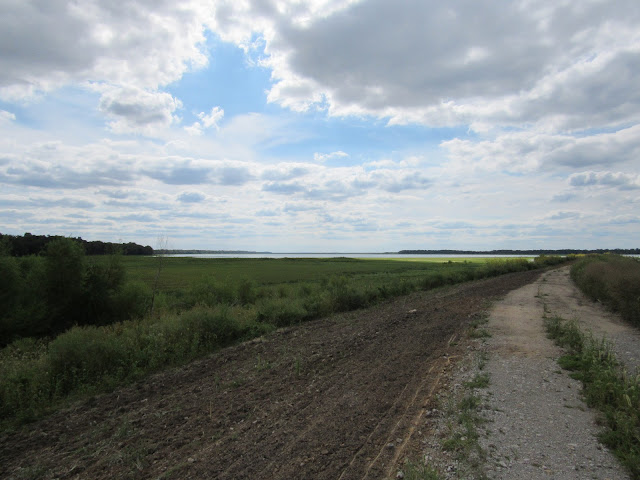Northwestern Mason County
Saturday, September 3, 5:00 AM- 5:00 PM
(Events referenced in this section are 11:00 AM to 1:00 PM and around 3:45 PM)
Temperature: 55-80 degrees Fahrenheit
Weather: Mostly sunny, winds out of northwest
Congratulations to those who have stayed with these rather overlong journals. I saved the best for last, in my opinion. The animals seen in Goofy Ridge and Emiquon are the rarest of the trip.
The local Osprey (Pandion haliaetus) was out and about at Goofy Ridge, named for the nearby village. This, two Bald Eagles, four Turkey Vultures, a few American White Pelicans, a Double-crested Cormorant, a flock of fifteen Canada Geese, a Great Blue Heron, and several swallows comprised the notable flyovers. There were probably more, but we didn't notice them for the grasshoppers, thousands of which I neglected to photograph.
Three Red-eared Sliders (Trachemys scripta elegans) greeted our arrival at the Goofy Ridge levee by sliding into the water. This area is quite a great turtle spot, as I was to find out later...
Indeed, the population of turtles here also engaged in photobombing this Great Egret (Ardea alba) photo. I count two in this photo, but like as not there's a couple more hidden underwater. Thankfully, the area lacked the thousands of dead rotting carp seen and smelled on a previous trip. I learned recently that this lake has massive Asian carp die-offs whenever the water levels are lowered during the summer. A few Ring-billed Gulls still picked around the edge of the lake, but my focus was here:
My favorite birds of the trip were these Black-necked Stilts (Himantopus mexicanus). Amazingly long legs and what appears to be a black helmet and coat on each bird make for a cartoonish appearance. The Black-necked Stilt has only recently begun to be seen here in great numbers. It's a happy story of a species on the rise, and as such has gone nearly undocumented by the news.
A Spotted Sandpiper (Actitis macularius) and four Lesser Yellowlegs (Tringa flavipes) stood on a nearby log, intermittently grooming themselves and stalking insects on the log.
Over on the bank, meanwhile, a mysterious turtle lived. I have never seen any turtle in Illinois with the head, tail, legs, and shell of this one. At first I though it was a Snapping Turtle, but after a second consideration, I have determined that it may remain unknown. This section of Illinois has many rare turtles, and it is possible that this is one of those, unknown to me. This is quite possibly some species of Map Turtle, the four of which in Illinois I am quite unfamiliar with.
I have gotten rather off topic. A Cooper's Hawk (Accipiter cooperii) flew overhead, and we turned back at that point. A friend and I walked back slower than the rest, as I'd seen something in the brush near our turning point. It turned out to be a couple of Eurasian Tree Sparrows. As we came back, she spotted this "lovely" spider in the brush:
It was the day's second Yellow Garden Spider (Argiope aurantica) (I found one later, at H.A. Gleason Nature Preserve). I wish I liked spiders better, but as it is, a spider this large terrifies me. With legs, this spider is easily as wide as the palm of my hand. It was busy eating grasshoppers as we watched. We yelled at the rest of the group to come back and see it, but they were too far away, distracted by some other bird, so we ran up to meet them.
There was an Eastern Wood-Pewee and a few Barn Swallows, but the big draw was a female Rose-breasted Grosbeak (Pheucticus ludovicianus) feeding in a tree over the parking lot. We went to leave, when something hopped out from under my car. I dived for it, and it hopped away. On my hands and knees, I crawled after it, and caught the amphibian, an American Toad (Anaxyrus americanus):
After showing this off to the others, I released the toad. As I did so, I came across this Turbulent Phosphila (Phosphila turbulenta) caterpillar, the larval stage of an unremarkable brown moth. I often wonder whether moth caterpillars like this are analogous to people I know, who live colorful lives while young but may become dull and commonplace when they get a bit older. Philosophizing aside, this is a neat caterpillar to find. It lives on greenbriar vines, often in groups.
We stopped in Havana for a bit of lunch, where I got in the van with the rest of the class (having driven separately until then) and then we took off for Emiquon Preserve, where I practiced my lackluster skills at photographing moving birds from a moving vehicle:
To be fair, this would never have been a great Black-crowned Night Heron (Nycticorax nycticorax) picture. I'm fairly proud of the fact that I got it in general. This rare, State-Threatened heron is, as its name suggests, nocturnal, and despite its black, white, and gray colors, remarkably hard to find even where it is common. Evidently, this works in the bird's favor, since it is found worldwide. Three Wood Ducks, ten Mallards, fifteen Blue-winged Teal, a Turkey Vulture and a Belted Kingfisher later, we spotted something else fairly interesting in the shallows off the road:
Two juvenile Little Blue Herons (Egretta caerulea) were the next birds to find. These southern herons regularly drift up to Emiquon and other parts of Central Illinois just after leaving their nests. State-Endangered, these small herons are often found with Snowy Egrets, but such was not the case on this day. If there is one bird in Illinois I have looked for the hardest, it is the Snowy Egret. Every weekend, several birdwatchers go to Emiquon and report several Snowy Egrets. I have been there on the average of once a month since May, and I haven't seen one. This considerably irritates me. But I digress. Our finding these two herons was quite good luck. The way to identify any heron is the bill. A Great Egret has a solid yellow bill, while a Snowy Egret has a black bill with a yellow base. In the case of the Little Blue Heron, these birds have a silvery-blue bill with a dark tip. As soon as we got out of the van to identify these birds, they departed for other sections of Thompson Lake.
Thompson Lake is the main body of water at Emiquon, and on this particular day, it was covered in pelicans, egrets, and gulls. We saw about two hundred Ring-billed Gulls, fourteen Great Egrets, and seventy-odd American White Pelicans, all fishing after their means. The gulls pounced on fish from the sky, while the egrets stalked slowly in the shallows.
Meanwhile, the American White Pelicans (Pelecanus erythrorhynchos) cruised the lake, dipping their bills occasionally in the water and catching fish. Just recently, a few pelicans were spotted on Lake Springfield, so keep your eyes out for huge white birds.
Painted Turtles (Chrysemys picta) watched us from the rocks surrounding the visitor's center. Also:
Northern Cricket Frogs (Acris crepitans), one of our most common little frog species, hopped about in the rocks. We must have found a half-dozen on the edge of the lake, all hidden in the riprap.
While looking at the frogs, I spotted this damselfly. Invertebrates here are too numerous to count, though thankfully the mosquitoes are rather limited by all their predators in this area.
Up at the reopened boardwalks, I spotted this Great Blue Heron (Ardea herodias), which watched our little band from its perch on the boardwalk, next to the sign. I've never been to this part of Emiquon, which has been closed to me for the last few trips.
Under a shade structure frequented by wasps, we spotted a few Cliff Swallow nests. Most of these birds have since flown south, but I spotted one flying overhead. These birds are some of the few that have done well out of modern buildings, using underpasses, bridges, and other manmade structures to affix their mud-built nests. About twenty Northern Rough-winged Swallows and five Double-crested Cormorants flew overhead as we watched.
Meanwhile, on the boardwalk, the Great Blue Heron decided to stay put and give me a perfect shot of its tongue. Who knew they had a barbed tongue?
As we went to leave, a Leopard Frog (Lithobates spp.) hopped out near our van. It was an excellent capper to a good trip at Emiquon, but as you know, I kept going, all the way to Goofy Ridge again.
The first bird back at Goofy Ridge was a Bald Eagle (Haliaeetus leucocephalus), and a decent one at that. Most of the Bald Eagles I've seen at Chautauqua have been immatures, like this one, brownish until about five years of age. All these juveniles are a sign of a strong, growing population. It's a good sign to see this species on the rebound, particularly after a recent estimate I read that we're short a billion birds compared to 1970 records, especially grassland and/or insect-eating birds affected by pesticides and more intensive farming. It's bad, but at least we know it happened, and this survey left out waterfowl, one of the faster-recovering groups of birds. If you read nature news too often, you get too pessimistic. To quote Jurassic Park, "Life, uh, finds a way."
Goofy Ridge Levee looks out, as it always does, over a vast wetland meadow and huge lake. About forty Canada Geese foraged at the far end, along with three Great Egrets and about ten Ring-billed Gulls. Overhead, a Pectoral Sandpiper flew north, one of the hundreds in the area. The Black-necked Stilts still foraged in their pond, and I quietly contemplated the scenery.
Off in the far distance, hundreds of shorebirds and pelicans could be seen, resting on the edge of the water, too far for me to reach them. I walked a bit further, when I scared up about seventy-five of one of Illinois' more curious birds, the Eurasian Tree Sparrow (Passer montanus):
After careful examination of the animal's plain back and lack of front ridges, I have come to the conclusion that this last turtle is the state-endangered Smooth Softshell Turtle (Apalone mutica)- a real Fifth Orchid if ever there was. This river-dwelling turtle made an excellent cap to a full day of birdwatching. I had this new-ish reptile, eight lifer list birds, and several state-listed animals and plants. It justifies the nasty case of poison ivy I currently have from Revis and H.A. Gleason Nature Preserves, for certain! I have several more journals out to do, coming up, so be prepared for a glut of posts as I try to encapsulate all my Vertebrate Zoology adventures on this blog.
Ebird Checklists:
http://ebird.org/ebird/view/checklist/S31412091
http://ebird.org/ebird/view/checklist/S31412156
http://ebird.org/ebird/view/checklist/S31412221
http://ebird.org/ebird/view/checklist/S31412444





























Wow, lots of great finds Jared. I'm still waiting for a look at black-necked stilts. While I'm not exactly sure which turtle it is, take another look at your snapper photo- it's definitely not a snapper. The shell is too large, the head too small.
ReplyDeleteThanks, Tom! I wondered about that, but I don't know any other turtle with that set of claws. I know that it is quite an unusual turtle. If you ever end up in Illinois during the summer, let me know, and I shall try to get you a look at the stilts. It might make for an excellent Arbour Adventure.
Delete